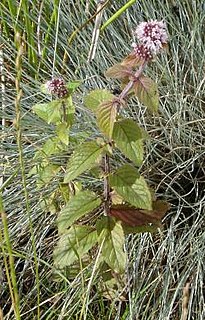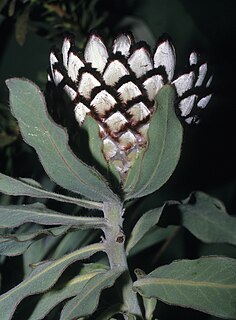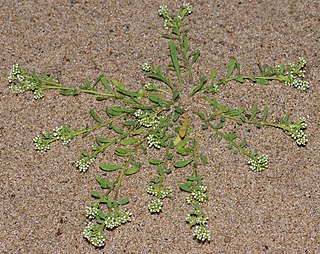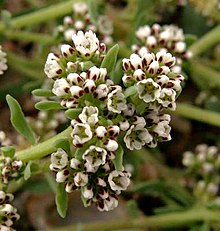
Grasslands are areas where the vegetation is dominated by grasses (Poaceae). However, sedge (Cyperaceae) and rush (Juncaceae) can also be found along with variable proportions of legumes, like clover, and other herbs. Grasslands occur naturally on all continents except Antarctica and are found in most ecoregions of the Earth. Furthermore, grasslands are one of the largest biomes on earth and dominate the landscape worldwide. There are different types of grasslands: natural grasslands, semi-natural grasslands, and agricultural grasslands. They cover 31–43% of the Earth's land area.

Caryophyllaceae, commonly called the pink family or carnation family, is a family of flowering plants. It is included in the dicotyledon order Caryophyllales in the APG III system, alongside 33 other families, including Amaranthaceae, Cactaceae, and Polygonaceae. It is a large family, with 81 genera and about 2,625 known species.

Mentha aquatica is a perennial flowering plant in the mint family Lamiaceae. It grows in moist places and is native to much of Europe, northwest Africa and southwest Asia.

Schoenoplectus is a genus of plants in the sedges with a cosmopolitan distribution. Note that the name bulrush is also applied to species in the unrelated genus Typha as well as to other sedges. The genus Schoenoplectus was formerly considered part of Scirpus, but recent phylogenetic data shows that they are not closely related.

The Balsaminaceae are a family of dicotyledonous plants, comprising two genera: Impatiens, which consists of over 1000 species, and Hydrocera, consisting of 1 species. The flowering plants may be annual or perennial. They are found throughout temperate and tropical regions, primarily in Asia and Africa, but also North America and Europe.

The Molluginaceae are a family of flowering plants recognized by several taxonomists. It was previously included in the larger family Aizoaceae. The APG III system of 2009 made no change in the status of the family as compared to the APG II system of 2003 and the APG system of 1998, apart from a reassignment of several genera, such as the placement of Corrigiola and Telephium into Caryophyllaceae, Corbichonia in Lophiocarpaceae, Microtea into Microteaceae and Limeum in Limeaceae, because the family was found to be widely polyphyletic in Caryophyllales. In addition Macarthuria was found not to be related to Limeum as previously thought and thus it was placed in Macarthuriaceae, and similarly species formerly placed in Hypertelis, apart from type species Hypertelis spergulacea, a true Molluginaceae, were found to belong elsewhere and were described as Kewa in the family Kewaceae, named for the Royal Botanic Gardens Kew. Molluginaceae is still assigned to the order Caryophyllales in the clade core eudicots, although the generic circumscription is difficult because Mollugo is not monophyletic.

Slapton Ley is a lake on the south coast of Devon, England, separated from Start Bay by a shingle beach, known as Slapton Sands.

Verbena brasiliensis, the Brazilian verbena or Brazilian vervain, is a flowering plant species from the vervain family (Verbenaceae). It is native to parts of South America, namely Brazil, but has spread its range in recent times and has occasionally become an invasive weed. It is an annual plant with purple flowers, and it has been introduced outside of its native range as an ornamental plant, and is now largely considered an invasive weed in these regions.

Schizanthus, also called butterfly flower, fringeflower, poor-man's-orchid, is a genus of plants in the nightshade family, Solanaceae.

Brunsvigia is a genus of African flowering plants in the family Amaryllidaceae, subfamily Amaryllidoideae. It contains about 20 species native to southeastern and southern Africa from Tanzania to the Cape Provinces of South Africa.

Protea laurifolia, also known as the grey-leaf sugarbush, is a shrub from South Africa. It is native to the Cape Provinces of South Africa.

Palpita vitrealis, common name jasmine moth or white pearl, is a species of moth of the family Crambidae.

Ilex, or holly, is a genus of over 560 species of flowering plants in the family Aquifoliaceae, and the only living genus in that family. Ilex has the most species of any woody dioecious angiosperm genus. The species are evergreen or deciduous trees, shrubs, and climbers from tropics to temperate zones worldwide. The type species is Ilex aquifolium, the common European holly used in Christmas decorations and cards.

Salix atrocinerea, commonly called grey willow or large gray willow, is a species of willow. It is a bush or small tree up to 12 m (39 ft) tall. As a pioneer species of willow, it quickly colonizes poor soils.

Iris spuria subsp. maritima is a species of the genus Iris, part of a subgenus series known as Iris subg. Limniris and in the series Iris ser. Spuriae. It is a subspecies of Iris spuria, a beardless, rhizomatous perennial plant, from coastal regions Europe and north Africa with deep blue-violet flowers.

Cyperus longus is a species of sedge known by the common names of sweet cyperus and water rush in Africa, or galingale in Britain. It is a tall plant, growing up to a metre in height, with creeping rhizomes and erect, triangular stems, each terminating in an inflorescence. The species grows in shallow water or on damp ground, such as at pond edges.

Protea canaliculata, also known as the groove-leaf sugarbush, is a species of flowering shrub of the genus Protea, which is endemic to the Cape Provinces of South Africa.

Protea holosericea, commonly known as the Sawedge Sugarbush, is a flowering shrub belonging to the Protea genus. The plant is endemic to South Africa and is found only on Sawedge Peak and Rabiesberg, two adjacent peaks in the Kwadousberg Mountains in the Western Cape.
Telephium are a genus of flowering plants in the family Molluginaceae or Caryophyllaceae, found in Mediterranean parts of Europe, Africa, the Arabian Peninsula, and western Asia. They are annual or perennial herbs, sometimes becoming woody at their bases. Together with Corrigiola they form the tribe Corrigioleae.

Corrigiola, the strapworts, are a genus of flowering plants in the family Caryophyllaceae, with a highly disjunct distribution in Mexico, South America, southern and eastern Africa, Madagascar, northwestern Africa, Europe and western Asia. Together with Telephium they form the tribe Corrigioleae.



















